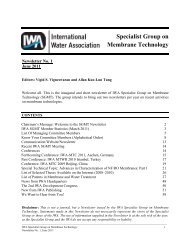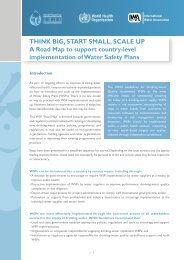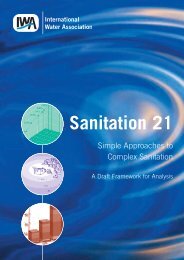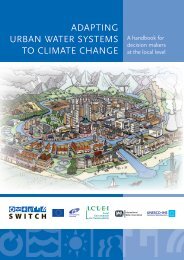Water and Energy - Draft Report of the GWRC Research ... - IWA
Water and Energy - Draft Report of the GWRC Research ... - IWA
Water and Energy - Draft Report of the GWRC Research ... - IWA
Create successful ePaper yourself
Turn your PDF publications into a flip-book with our unique Google optimized e-Paper software.
Annex G. Information on Member <strong>and</strong> Partner Activities<br />
Organisation: AwwaRF<br />
Contact person: Linda Reekie<br />
Email address: LReekie@awwarf.org<br />
Available reports<br />
<strong>Energy</strong> Management for <strong>Water</strong> <strong>and</strong> Wastewater Utilities (Reardon, 1994)<br />
The research was sponsored by AwwaRF <strong>and</strong> <strong>the</strong> Electric Power <strong>Research</strong> Institute Community<br />
Environmental Center (EPRI-CEC) <strong>and</strong> published by EPRI. It provides a detailed look at<br />
electricity consumption for several generic processes used in water <strong>and</strong> wastewater plants. It<br />
describes energy usage patterns for water <strong>and</strong> wastewater <strong>and</strong> identifies opportunities for a<br />
variety <strong>of</strong> energy management options. Included are energy management approaches <strong>and</strong> case<br />
study applications.<br />
Ozone System <strong>Energy</strong> Optimization H<strong>and</strong>book (DeMers, Rakness, <strong>and</strong> Blank, 1996)<br />
The research was sponsored by AwwaRF <strong>and</strong> <strong>the</strong> Electric Power <strong>Research</strong> Institute Community<br />
Environmental Center (EPRI-CEC) <strong>and</strong> published by AwwaRF. It is <strong>the</strong> first publication <strong>of</strong> a<br />
three-phase collaborative research effort between <strong>the</strong> two organizations called <strong>the</strong> “Ozone<br />
<strong>Energy</strong> Optimization Project.” It reports on development <strong>of</strong> a st<strong>and</strong>ardized protocol for<br />
evaluating ozone system optimization. The protocol was established through conducting three<br />
ozone facility evaluations <strong>of</strong> about one-week duration <strong>and</strong> follow-up efforts.<br />
Ozone Facility Optimization <strong>Research</strong> Results <strong>and</strong> Case Studies (Rakness <strong>and</strong> DeMers, 1998)<br />
The research was sponsored by AwwaRF <strong>and</strong> EPRI-CEC <strong>and</strong> published by AwwaRF. It is <strong>the</strong><br />
second publication <strong>of</strong> a three-phase collaborative research effort between <strong>the</strong> two organizations<br />
called <strong>the</strong> “Ozone <strong>Energy</strong> Optimization Project.” It reports on <strong>the</strong> evaluation <strong>of</strong> ten operating<br />
ozone facilities to exp<strong>and</strong> <strong>the</strong> database <strong>of</strong> information about ozone facilities. It looks at case<br />
study examples <strong>and</strong> strategies for achieving optimization.<br />
Advancing Ozone Optimization During Pre-Design, Design <strong>and</strong> Operation (Rakness <strong>and</strong><br />
Hunter, 2000)<br />
The research was sponsored by AwwaRF <strong>and</strong> EPRI-CEC <strong>and</strong> published by EPRI. It is <strong>the</strong> third<br />
publication <strong>of</strong> a three-phase collaborative research effort between <strong>the</strong> two organizations called<br />
<strong>the</strong> “Ozone <strong>Energy</strong> Optimization Project.” It condenses ideas for ozone optimization during predesign,<br />
design, <strong>and</strong> operation based on findings during Phases 1 <strong>and</strong> 2 <strong>and</strong> selected special<br />
studies during Phase 3. The study found potential for lowering capital cost through optimization<br />
during pre-design using redundancy <strong>and</strong> st<strong>and</strong>by equipment. In addition, ozone dem<strong>and</strong> <strong>and</strong><br />
decay should influence generator <strong>and</strong> contact sizing decisions. Also, plant administration must<br />
make optimization a priority <strong>and</strong> staff must implement optimization strategies <strong>and</strong> monitor<br />
progress as well as keep meters in proper calibration <strong>and</strong> equipment in working order.<br />
<strong>Energy</strong> <strong>and</strong> <strong>Water</strong> Quality Management System (Curtice, Jentgen, <strong>and</strong> Ward, 1997)<br />
<strong>GWRC</strong> <strong>Water</strong> & <strong>Energy</strong> - <strong>Draft</strong> report<br />
45

















